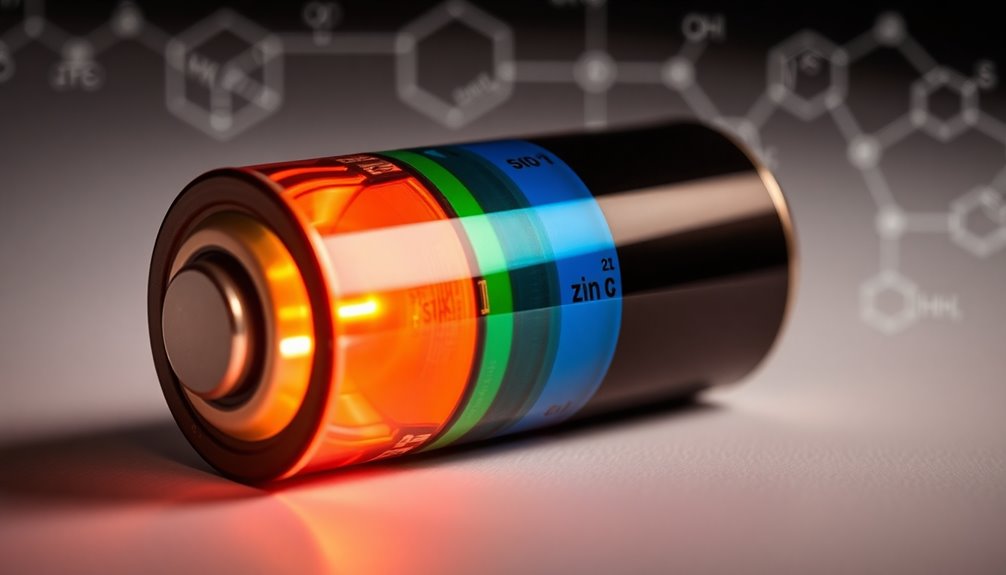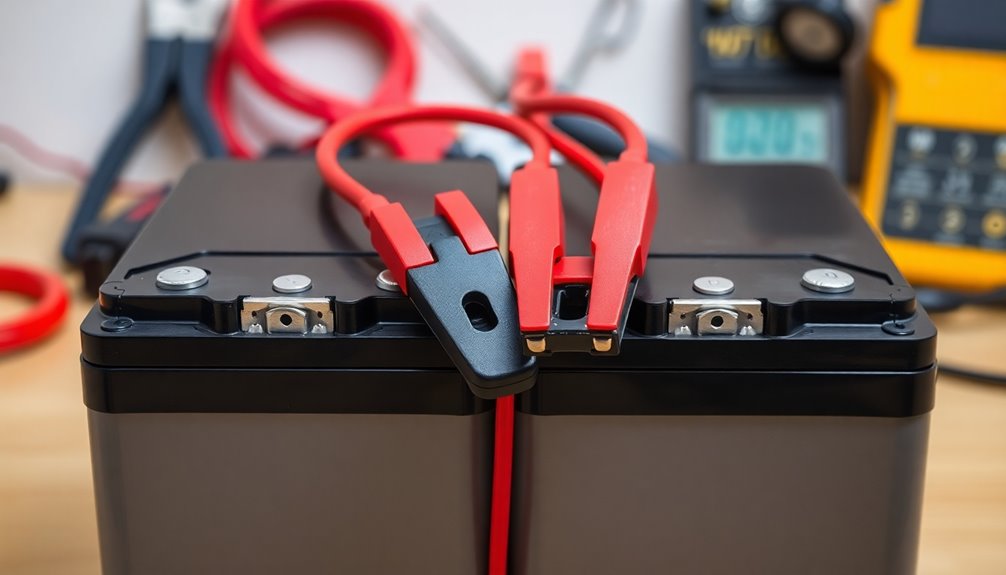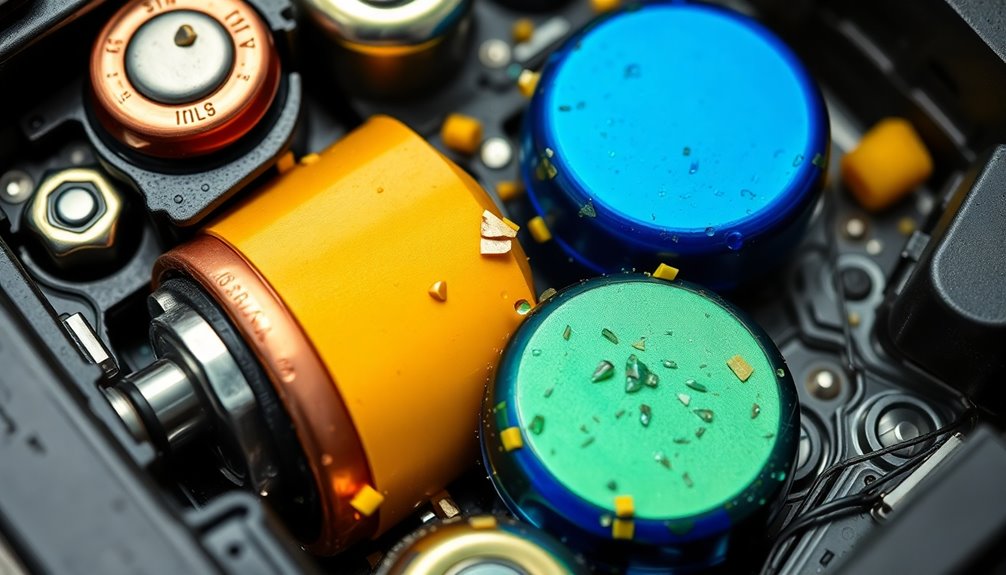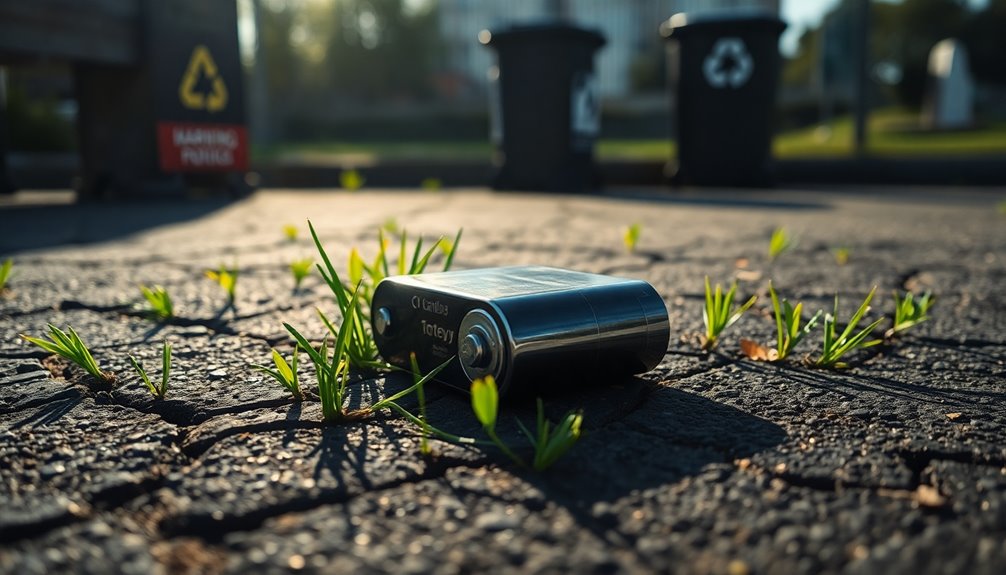Batteries work by converting chemical energy into electrical energy. They consist of two electrodes—the anode and the cathode—and an electrolyte that allows ions to move. When you use a battery, chemical reactions occur at the electrodes, releasing and accepting electrons, which create an electric current. Most batteries generate about 1.5 volts. You'll find primary batteries for single use and rechargeable ones for multiple cycles. Factors like temperature and battery design can impact performance. Understanding these basics opens the door to learning about different battery types and future advancements in battery technology.
Key Takeaways
- Batteries convert chemical energy into electrical energy through electrochemical reactions between two electrodes: the anode and cathode.
- The anode undergoes oxidation, releasing electrons, while the cathode undergoes reduction, accepting electrons.
- A typical electrochemical cell generates about 1.5 volts, creating a flow of electrons that produces electric current.
- Rechargeable batteries allow for the reversal of chemical reactions, enabling multiple charging cycles and extended use.
- Environmental sustainability is a growing concern, prompting innovations in battery materials and recycling practices to reduce ecological impact.
Understanding Batteries
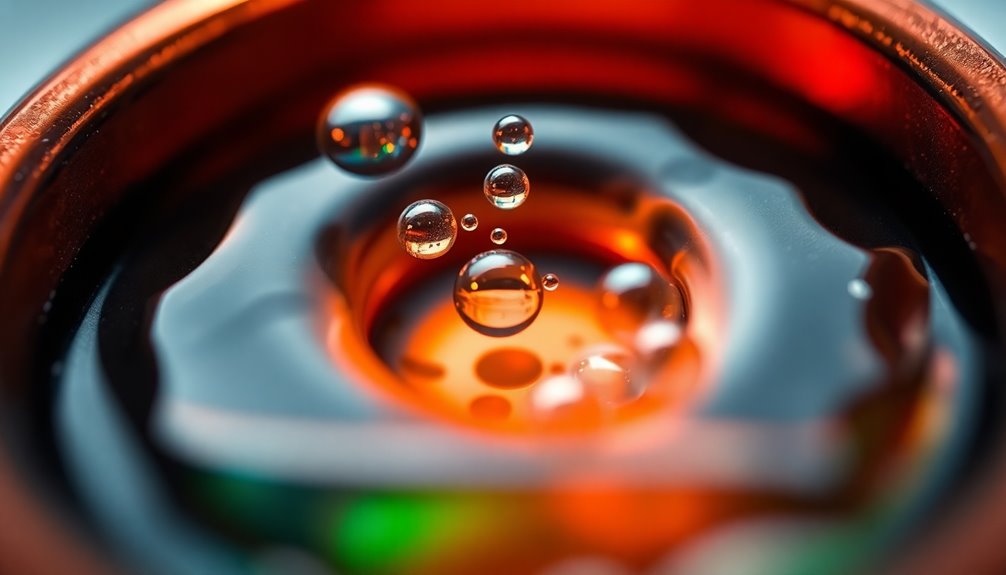
Batteries are fascinating devices that store and convert chemical energy into electrical energy. Inside each battery, you'll find two electrodes: the anode and cathode, along with an electrolyte.
When you use a battery, a chemical reaction occurs at the anode, causing oxidation and releasing electrons. These electrons flow through an external circuit to the cathode, generating an electric current. The movement of ions through the electrolyte balances this flow of electrons, maintaining the circuit.
Rechargeable batteries are particularly interesting because you can reverse their chemical reactions by applying external energy, allowing you to use them multiple times.
The battery's capacity depends on its chemical composition, with lithium-ion batteries often providing high energy density and low self-discharge rates.
Key Components of a Battery

At the heart of every battery lie key components that work together to produce electricity.
You'll find two electrodes: the anode, which is negative, and the cathode, positive. These electrodes facilitate the flow of electrons during chemical reactions. The electrolyte is essential too; it's the medium that allows charged ions to move between the anode and cathode, balancing the electron flow and generating electric current.
In these reactions, oxidation occurs at the anode, releasing electrons, while reduction happens at the cathode, accepting those electrons. This continuous cycle allows batteries to function until the reactants are depleted.
Each electrochemical cell typically generates about 1.5 volts, housed safely by an outer casing that insulates and protects the internal components.
How Batteries Generate Electricity

Batteries generate electricity through chemical reactions between the anode and cathode that create a flow of electrons.
As you use the battery, the electrolyte helps ions move between these two electrodes, balancing the electron flow in your device.
Understanding this process reveals how batteries power everything from remote controls to electric cars.
Chemical Reactions In Batteries
When a battery is in use, it generates electricity through electrochemical reactions involving the anode, cathode, and electrolyte. Here's how it works:
- Chemical Reactions: At the anode, oxidation occurs, losing electrons, while reduction happens at the cathode, gaining electrons.
- Electrodes: The materials used for the anode and cathode considerably influence performance.
- Electrolyte: This medium allows ions to move between electrodes, facilitating the redox reaction.
- Electron Flow: As electrons flow through the external circuit, they power your devices.
Rechargeable batteries, like lithium-ion batteries, can reverse these reactions, restoring energy storage.
The efficiency of energy generation relies on the chosen materials, with lithium and fluoride combinations producing some of the highest voltages.
Electron Flow Mechanism
As electrons are released during the chemical reactions at the anode, they flow through the external circuit to the cathode, generating electric current.
This movement of electrons from the negative terminal (anode) to the positive terminal (cathode) is a result of oxidation-reduction reactions within the battery.
As the electrons flow, positive ions traverse through the electrolyte to maintain charge balance, ensuring the battery can continuously deliver power.
The standard output voltage of common batteries, like alkaline cells, is around 1.5 volts, determined by the electrochemical potential difference between the anode and cathode materials.
Rechargeable batteries can reverse this electron flow and chemical reactions during charging, restoring energy storage for future use.
Role of Electrolytes
Electrolytes are the unsung heroes of battery operation, enabling the flow of ions that keeps the electric current flowing.
They're essential for the movement of positive ions between the anode and cathode during discharge, balancing electron flow.
Here's how they impact battery function:
- Conductivity: High conductivity enhances ion movement.
- Chemical Reactions: They facilitate important reactions during discharge and charging.
- Performance: Different electrolytes, like potassium hydroxide or lithium salt, affect overall voltage and efficiency.
- Temperature and Concentration: These factors can influence electrolyte effectiveness.
In rechargeable batteries, electrolytes reverse chemical reactions, restoring stored energy.
Types of Batteries

Batteries come in various types, each serving different needs and applications. You'll find primary batteries, like alkaline and zinc-carbon, designed for single-use and commonly powering household devices. Alkaline batteries typically provide about 1.5 volts, making them great for remotes and flashlights.
On the other hand, secondary batteries are rechargeable, such as lithium-ion, which are known for their high energy density and low self-discharge rates of just 2-3% per month. These dominate the consumer electronics market, powering smartphones and electric vehicles.
Lead-acid batteries, while heavy and toxic, are reliable for starting engines in vehicles. As technology evolves, new types, like solid-state and lithium-sulfur batteries, promise improved energy density and safety, reducing environmental impact.
Rechargeable vs. Non-Rechargeable
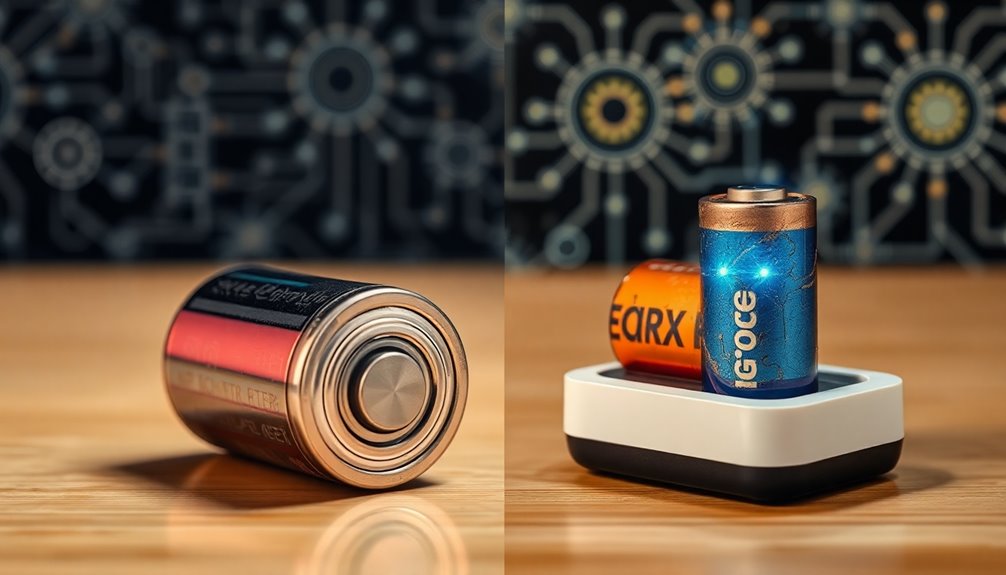
While many people rely on batteries for everyday devices, understanding the difference between rechargeable and non-rechargeable options is essential for making informed choices.
Here's a quick comparison:
- Rechargeable Batteries: These, like lithium-ion and nickel-metal hydride, use reversible chemical reactions, allowing them to be cycled multiple times.
- Non-Rechargeable Batteries: Alkaline and zinc-carbon batteries are single-use; once their energy is depleted, they can't be recharged.
- Waste: Non-rechargeable batteries contribute considerably to waste, whereas rechargeable options promote sustainability.
- Capacity: Rechargeable batteries generally have a higher initial cost but provide long-term savings and reduced waste.
Factors Affecting Battery Performance

Understanding the factors that affect battery performance can help you choose the right type for your needs. The chemistry of the battery greatly influences its energy storage capacity and efficiency. For instance, lithium-ion batteries offer higher energy density compared to nickel-cadmium batteries.
Voltage is essential too; higher voltage can enhance power output, boosting efficiency for your devices. Temperature effects also play a crucial role—extreme heat can accelerate harmful chemical reactions, while cold can hinder ion mobility, degrading performance.
Additionally, managing the State of Charge (SOC) and Depth of Discharge (DoD) is crucial. By maintaining ideal SOC and limiting DoD, you can greatly enhance your battery's longevity and overall performance.
Future of Battery Technology

As the demand for efficient and sustainable energy storage grows, the future of battery technology is becoming increasingly exciting. You can expect significant advancements in several areas:
- Solid-state batteries promise higher energy density and improved safety.
- Lithium-sulfur and sodium-ion batteries aim to reduce reliance on scarce materials.
- Liquid metal batteries from MIT's Group Sadoway could offer faster charge times and lower costs.
- Innovations in flexible designs lead to lightweight, nonflammable options suitable for various applications.
These developments emphasize sustainable practices, focusing on recycling and using abundant materials to minimize environmental impact while enhancing performance.
As these technologies mature, you'll likely see more efficient and eco-friendly energy solutions shaping the future.
Frequently Asked Questions
How Does a Battery Work in Simple Terms?
A battery works by turning stored chemical energy into electrical energy.
It has two parts, called electrodes, and an electrolyte in between. When you use the battery, one electrode releases electrons while the other accepts them, creating a flow of electricity. This flow powers your devices.
Once the chemicals are used up, the battery can't produce energy anymore, but you can recharge it to restore its power for future use.
What Is Battery in Basic Science?
Did you know that over 3 billion batteries are sold each year in the U.S. alone?
A battery, in basic science, is a device that stores chemical energy and converts it into electrical energy. It consists of two electrodes—an anode and a cathode—immersed in an electrolyte.
When you connect a battery to a circuit, electrons flow from the anode to the cathode, creating an electric current that powers your devices.
How Do You Explain a Battery to a Kid?
To explain a battery to a kid, you can say it's like a tiny power pack. When you put it in a toy, it helps the toy work by sending electricity.
Inside the battery, there are two special parts called electrodes, and they help move little particles called electrons.
You can also mention that some batteries can be recharged and used again, while others can only be used once.
What Is the Chemistry Behind Batteries?
The chemistry behind batteries involves electrochemical reactions between two electrodes: the anode and the cathode.
When you connect a battery, oxidation occurs at the anode, releasing electrons, while reduction happens at the cathode, which accepts those electrons. This flow creates an electrical current.
Different materials in the electrodes and electrolytes affect the battery's performance, such as energy density and voltage.
Understanding these reactions helps you appreciate how batteries power your devices.
Conclusion
In conclusion, batteries are fascinating devices that power our daily lives. Did you know that by 2030, the global battery market is expected to reach a staggering $100 billion? This growth reflects the demand for energy storage solutions and the push for renewable energy. As technology advances, you'll likely see even more efficient and eco-friendly batteries on the market. Staying informed about battery innovations can help you make smarter choices for your devices and the environment.



